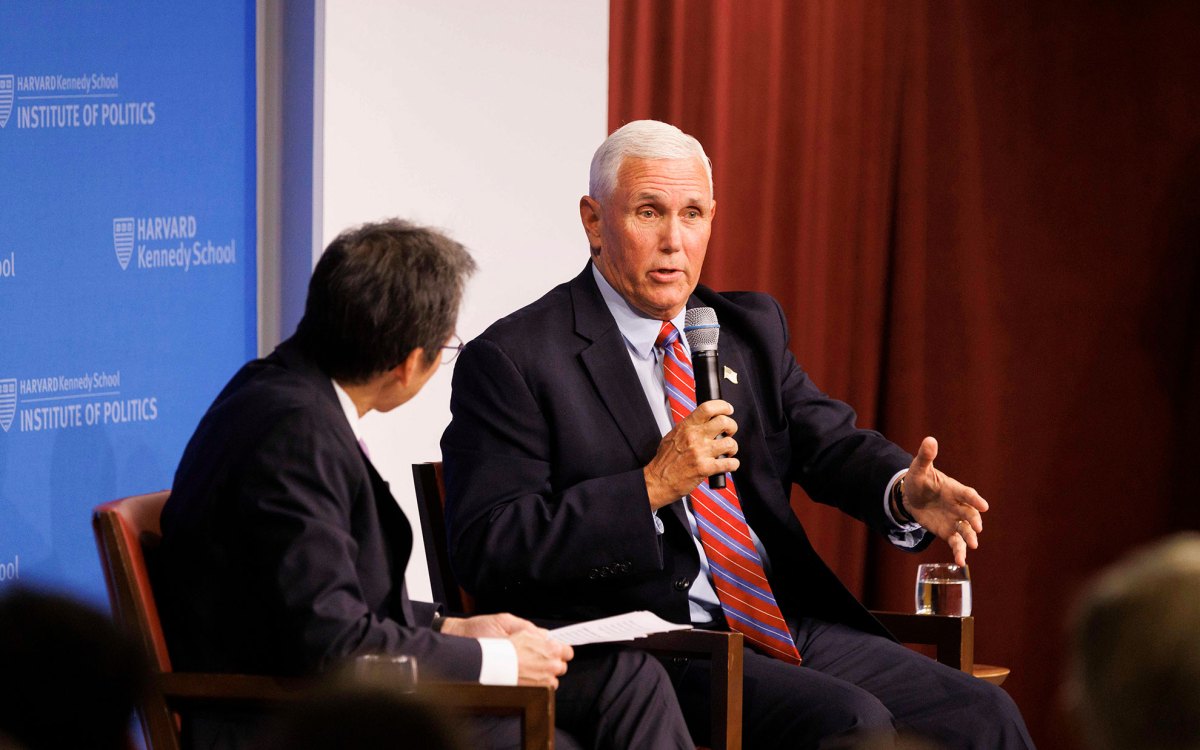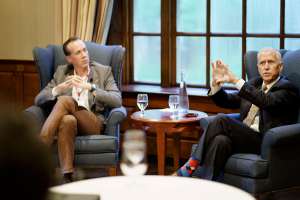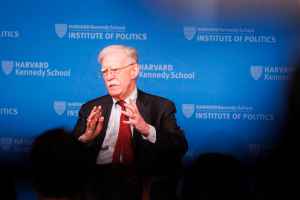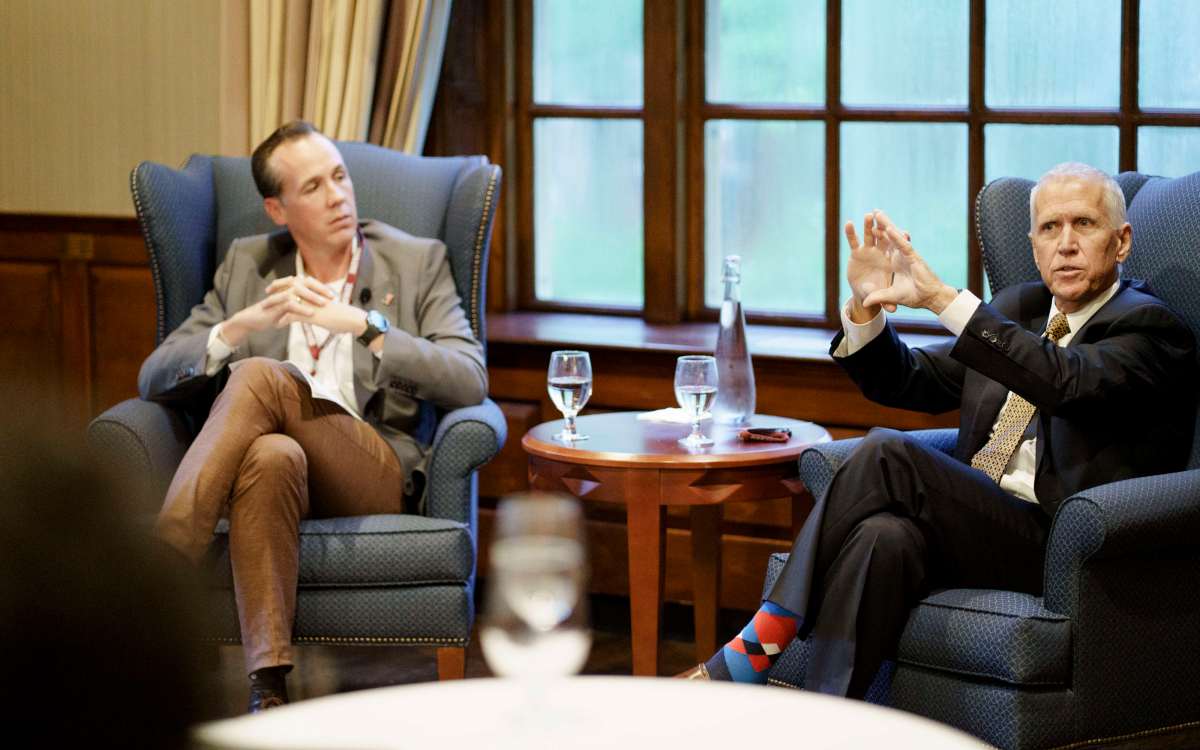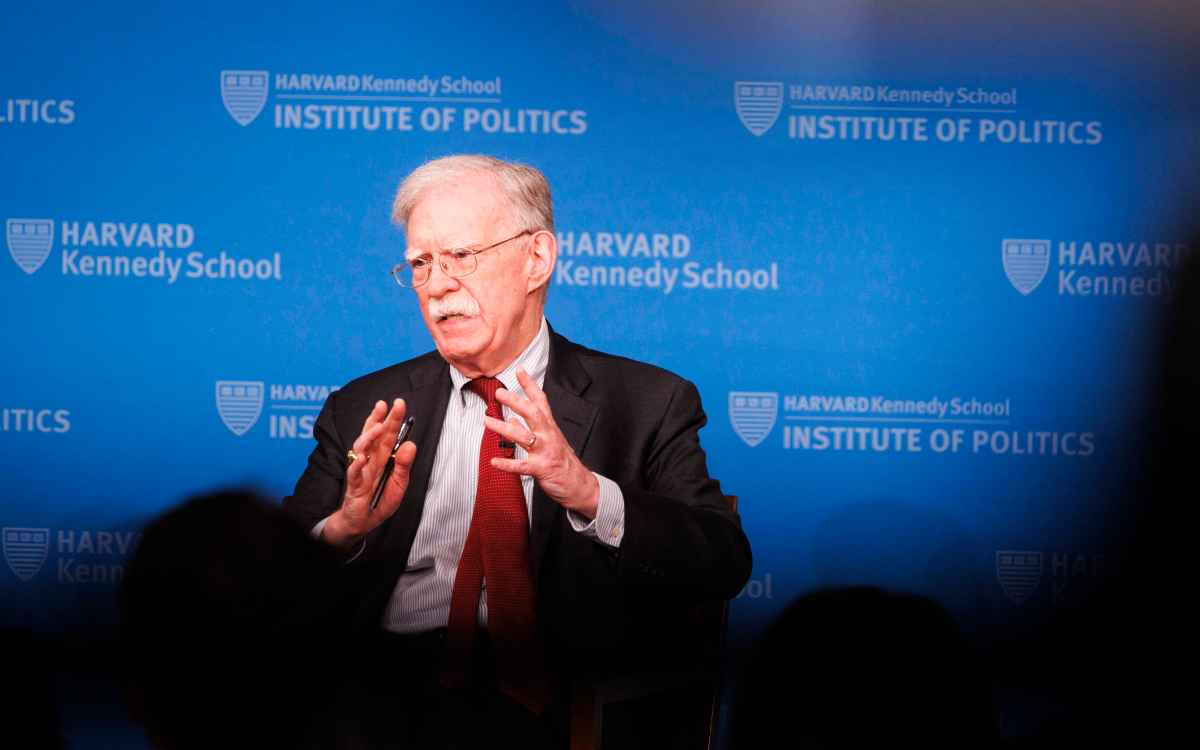
Yoni Appelbaum.
Photo by Jessica Torch
Americans used to move around a lot, chasing opportunity. No more.
Yoni Appelbaum argues legal, political hurdles over past 50 years have had troubling economic, social consequences
Excerpted from “Stuck: How the Privileged and the Propertied Broke the Engine of American Opportunity” by Yoni Appelbaum, lecturer in history and literature, ’14.
America is a nation of migrants. No society has ever been remotely so mobile as America at its peak. In the late 19th century, the heyday of American mobility, roughly a third of all Americans changed addresses each year. European visitors were astonished, and more than slightly appalled. The American, Michel Chevalier observed in 1835, “is devoured with a passion for locomotion, he cannot stay in one place.” On Moving Day, when leases expired in tandem, the greater part of a city’s population might relocate to new quarters between sunup and sundown, in a great jumble of furniture and carts and carpetbags. On average, Americans moved far more often, over longer distances, and to greater advantage than did people in the lands from which they had come. They understood this as the key to their national character, the thing that made their country distinctive. “We are a migratory people, and we flourish best when we make an occasional change of base,” explained one 19th century newspaper. “We have cut loose from the old style of human vegetation, the former method, of sticking like an oyster to one spot through numberless succeeding generations,” wrote another.
Every American has ancestors who decided to stop being oysters. The earliest of them came across Beringia and quickly peopled the land. Millennia later, people arrived from Europe and were just as quick to spread out, dispossessing those who had come before. But they did not simply arrive in one place and put down roots. Having come to this land, they never stopped moving. They loaded the cart, the wagon, the steamer trunk, or the moving van. They left the towns where they grew up to plant settlements, and then their children left those towns in turn to begin anew. In different eras, they headed in different directions: meadowlands and marshes, to graze their cattle; market towns, to ply their crafts; factories, to earn a wage; prairies, to lay claim to the land and till the soil; booming cities, to open a shop of their own. They went in search of economic opportunity, or liberty, or community. They went because they were forced to go, or because they sought freedom and equality. They went because they could not stay where they were, or because they did not want to. But they went.
The ceaseless migrations of the population shaped a new set of expectations. “When the mobility of population was always so great,” the historian Carl Becker observed, “the strange face, the odd speech, the curious custom of dress, and the unaccustomed religious faith ceased to be a matter of comment or concern.” A mobile population opened the possibilities of pluralism as diverse peoples learned to live alongside each other. The term “stranger,” Becker wrote, in other lands synonymous with “enemy,” instead became “a common form of friendly salutation.” In a nation where people are forever arriving and departing, a newcomer can seem less a threat to the settled order than a welcome addition to a growing community: “Howdy, stranger.” Mobility has long been the shaper of American character and the guarantor of its democracy.
Americans turned migration from the last resort of the desperate and the destitute into the exercise of a fundamental right. The Puritans arrived on American shores in the 17th century, they justified the abandonment of their proper homes and stations with the audacious claim that relocation can sometimes be respectable, or even laudable. They soon codified this right, the right to leave, into law. Their towns, though, were semi-sovereign entities, policing their boundaries, selecting their members, and regulating the behavior of their populations. Anyone could leave, but not just anyone could stay. Two centuries later, as the young United States pushed west, it would add a complementary liberty, if only to some the right to belong. Together, these ideas constituted a new and transformative freedom. Instead of allowing communities to choose their own members, Americans decided to allow most individuals to choose their communities.
A mobile population opened the possibilities of pluralism as diverse peoples learned to live alongside each other.
As Americans moved around, they also moved up. The extraordinary geographic mobility of the United States drove its equally distinctive levels of social and economic mobility. Though the process of moving was always wrenching, the pain of relocation real, people who went to new places often found new beginnings, new connections, new communities, and new opportunities. They had the chance to break away from stultifying social hierarchies, depleted farmland, and dead-end jobs. On average, migrants have always grown more prosperous than those who stayed in place, and conferred better futures on their children — a correlation that, remarkably, has remained robust across four centuries, in a society that has changed in countless other ways.
There were no guarantees. However green the grass appeared, many Americans crossed to the other side of the fence, only to find it withering beneath their feet. Boomtowns turned to ghost towns; entire industries became obsolete. And mobility was never uncontested. Waves of immigrants faced discrimination from those who had come only slightly before, turned away from communities they sought to join just because they were Irish, or Italian, or Jewish. Laws excluded the Chinese, and vigilantes hounded them from their homes. Women seldom enjoyed the full privilege of mobility, constrained by social strictures, legal barriers, and physical dangers.
And even after the end of slavery, Black Americans had to fight at every turn to exercise their mobility in the face of segregation and racist violence.
But members of all these groups, and others besides, kept moving whenever they were able, because they understood the link between mobility and opportunity. Where racists and nativists sought to keep new arrivals out, they insistently demanded to be let in. And when the first move didn’t work out, Americans of different backgrounds could always see some more promising destination beckoning them onward. They could light out for the territory, hit the road, stake their claim, or make a brand-new start of it in a city that never sleeps. Our culture is thick with the clichés of mobility.
The freedom to move opened space for political and religious diversity. People unhappy with the decisions their communities made were not locked into endless feuds, but could, with a minimum of capital, move to a place they found more congenial, voting with their feet. Social identities, too, were transformed from heritable characteristics into self-fashioned choices. The voluntary communities Americans created led to a remarkable flourishing of religious and associational life as new arrivals invested effort in building up relationships, making America a nation of joiners. Freed from the heavy weight of tradition, of the constraints of habit and precedent, the new nation became famed for its entrepreneurship and innovation and for the rapidity of its economic growth. Mobility distinguished the United States from the relative stasis of Europe. American institutions were tuned for the perpetual motion of the population, adapted to individuals relocating again and again in search of greater opportunity. The most distinctive features of the young republic all traced back to this single, foundational fact: Americans were always starting over, always looking ahead to their next beginning, always seeking to move up by moving on. Mobility has been the great engine of American prosperity, the essential mechanism of social equality, and the ballast of our diverse democracy.
But for the last 50 years, the engine of American opportunity has been grinding to a halt, throwing society into crisis. Americans have grown less likely to move from one state to another, or to move within a state, or to switch residences within a city. In the late 19th century, the heyday of American mobility, a third of all Americans might have changed addresses each year. In the 1940s and 1950s, about a fifth of Americans moved annually. By 2021, only one-twelfth of Americans moved. The drastic decline in geographic mobility is the single most important social change of the past half century, and perhaps the least remarked.
In 1970, about eight out of every 10 children turning 20 could expect to earn more than their parents did; by the turn of the century, that was true of only half, and the proportion is likely still falling.
What killed American mobility? There is no shortage of suspects. People have always been most mobile while they’re relatively young, and the country is aging. The median American was just 16 years old in 1800 and 28 in 1970, but more than 38 today. The spread of occupational licensing might have made it more costly to find jobs in new places. Or perhaps the answers reflect positive trends. As more women have gained entry into the workforce, two-career households might have found it increasingly difficult to relocate. The prevalence of joint custody makes it harder for members of divorced couples to move. More Americans own their homes, and renters have always been more mobile. Maybe Americans are just growing more successful and better able to locate jobs and communities that meet their needs, reducing their impulse to move someplace else. Maybe they are relying on remote work to stay where they are.
But none of these answers can possibly explain the broad, persistent declines in geographic mobility by itself, or even if you add them all together. The country may be older, but the drop has been particularly steep among younger Americans. The spread of occupational licensing is real, but most jobs aren’t licensed, and it accounts for perhaps 5 percent of the total decline. Two-earner households may be less mobile, but their mobility has declined in tandem with that of other groups. Mobility is down not just among homeowners but also among renters, and its decline antedates the rise of remote work. And just look around. Do Americans look happier and more satisfied to you?
But there is one more set of suspects, and the evidence for their guilt is damning: American mobility has been slowly strangled by generations of reformers, seeking to reassert control over their neighborhoods and their neighbors. At the beginning of the 20th century, reformers sought to apply the fruits of science and reason to manage growth, reimposing order and control on a jumbled and chaotic landscape that mixed shops and apartments in among the houses, and occupants of varied ethnicities and income brackets. Their chosen tools were building codes and restrictive covenants and zoning ordinances, designed to segregate land by use and class and race. New Deal bureaucrats next took up the cause, requiring local jurisdictions to apply these tools to their communities and putting new construction firmly under the purview of government. Then, in the postwar decades, skepticism of big business and big government led a new generation of activists to empower individuals and groups to challenge decisions made by bureaucrats. This varied lot of reformers acted from a wide mix of motives, some laudable and others despicable. Some would probably appreciate what they have wrought, while others would be appalled at the unintended consequences of their work. But taken together, the reforms that they enacted have created a peculiarly dysfunctional system. Almost all new construction in the United States now requires government approval, and anyone with sufficient time and resources and education can effectively veto that approval, or at least impose great expense and delay. The result is that in the very places that need it most desperately, housing has become prohibitively difficult to build. If the freedom to move was originally secured by allowing Americans to choose their own communities, then it has been undone by a series of legal and political changes that restored the sovereignty of local communities and allowed them again to select their own members.
These changes took hold so gradually that most Americans are unaware of how radically they have altered their society. For most of our history, a highly mobile population moved toward opportunity. When a place prospered, it quickly swelled with new arrivals. Builders rushed to meet the demand with housing. Farms gave way to clusters of houses, which turned into town houses, which sprouted into apartment buildings or even high-rises. But in today’s burgeoning metropolises and boomtowns, restrictions have effectively frozen the built environment. As a result, housing has grown artificially scarce and prohibitively expensive. A fortunate few can still afford to move where they want. Most people, though, would have to pay so much more for housing in prospering cities that offered better jobs that relocation would leave them worse off overall. Americans aren’t moving anymore, because for so many moving threatens to cost more than it delivers.
The costs of our national sclerosis are frightening to contemplate. More Americans have stopped starting new businesses. Between 1985 and 2014, both the total share of entrepreneurs in the population and the share of people newly becoming entrepreneurs fell by half. More Americans have stopped finding new jobs. Switching jobs frequently when you’re young correlates with occupational and economic mobility, but the share of people switching industries, occupations, and employers has fallen dramatically, particularly among younger workers; they’ve grown less likely to work for four or more employers by the time they’re thirty and more likely to work for just one or two. And more Americans are ending up worse off than their parents. In 1970, about eight out of every 10 children turning 20 could expect to earn more than their parents did; by the turn of the century, that was true of only half, and the proportion is likely still falling.
As grim as the economic indicators might be, the measures of social health are even more alarming. Compared with Americans at the beginning of the 1970s, the average American today belongs to about half as many groups. Church membership is down by about a third, as is the share who socialize with folks around them several times a week. A majority of Americans tell pollsters that their social isolation has left them anxious and depressed. Americans are having fewer children. And while half of Americans used to think most people could be trusted, today only a third think the same. So Americans aren’t starting new businesses, switching to better jobs, or climbing the social ladder the way they used to. They’re not joining groups, gathering in prayer, having kids, or hanging out the way they used to. They don’t even trust each other anymore. They are, in a word, stuck.
Copyright © 2025 by Yoni Appelbaum. Published by Random House, an imprint and division of Penguin Random House LLC. All rights reserved.
